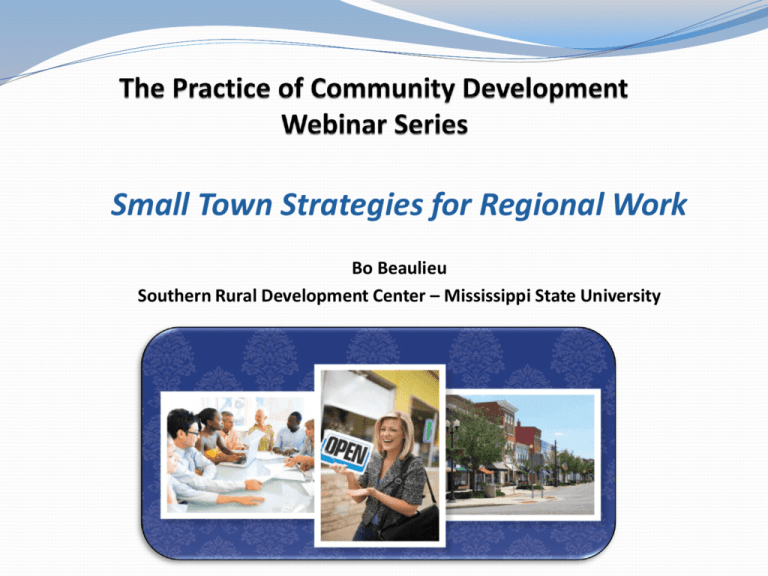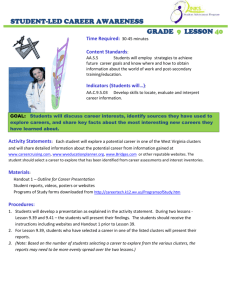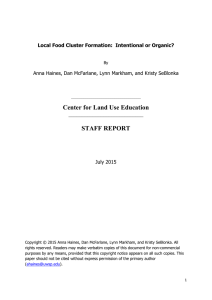File - Purdue Center for Regional Development
advertisement

Small Town Strategies for Regional Work Bo Beaulieu Southern Rural Development Center – Mississippi State University Webinar Overview Defining what we mean by region Types of regions Why a regional approach Features of successful regions Components of the SET (Stronger Economies Together) Program Examples of SET regional efforts SET metrics What’s ahead with SET: Phase IV Q&A DEFINING A REGION: DIFFERENT APPROACHES What is a Region? Geographical area of similar characteristics: Similar within Different from other places Place with a unique identity and meaning Types of Regions Functional Economic Political Administrative Data “Issue” Each of these regions is valid. Which one you use simply depends on what you are attempting to do. Why a Regional Approach? Secretary of Agriculture, Tom Vilsack “I have reached the conclusion that we must overhaul our approach to economic development in rural America. The framework of the new effort recognizes that the rural economy of tomorrow will be a regional economy. No one community will prosper in isolation.” Do you agree with Secretary Vilsack? Why or why not? Why a Regional Approach? Promotes the Three Cs: Conversation Connection Capacity Source: Council on Competitiveness (2010) KEY FEATURES OF SUCCESSFUL REGIONS Features of Successful Regions • Leaders that recognize new realities of economic development • Commitment to collaboration • Global view • Understanding of current strengths and weaknesses • Flexibility and adaptability Features of Successful Regions • Capacity to respond; the structure to support activities • Comprehensive view of development • Mechanism for continuously searching for opportunities • Way to document impact Rating Your Region: Taking Stock Needs Lots of Work Mixed Reviews In Pretty Good Shape An Introduction to SET Purpose of SET Help rural communities/counties work together as a regional team in developing and implementing an economic development blueprint that builds on the current and emerging economic strengths of their region. When Launched? Summer 2010 States Currently Part of SET SET Regions: A Bottom-Up Approach SET states selected State Partner & Training Teams mobilized Counties & communities invited to apply as a SET region Regions defined by applicants State Partner Teams review applications and submit recommendations to USDA RD USDA RD finalizes list of successful applicants SET regions announced; work with regions begins Reaching Rural Places: Current SET Counties n = 233 Counties Involved in SET: Facing Key Challenges Percent 60 n = 233 50 50.2 40 30 31.8 30.9 20 26.2 27 Population Loss Mfg. Dependent 10 0 Low Education Low Employment Persistent Poverty Note: Based on the ERS 2004 County Typology Codes What SET Provides Regional Teams Technical Assistance Training Data & Analysis Peer-to-Peer Networking SET Core Training Modules The Basics The SET Initiative: An Introduction Gearing Up Building a Strong Regional Team Resources & Strategies Focusing on Regional Comparative Advantage Moving Into Action Planning for Success Exploring Strategies for Enhancing the Regional Economy Profiling Your Region Developing Your Vision and Goals Discovering Assets & Barriers Measuring for Success Bringing Information to the Table Current county and/or community economic development plans Demographic profile Analysis of economic clusters The North Carolina Eastern Triangle Review the NCET Data Study the handout Identify information that you found most interesting What impact might such data have on the economic development planning by a regional team? Clusters in Your Region What is the nature of the clusters that you are most familiar with in your region (that is, the region you most closely identify with)? Stars Emerging Maturing Transitioning What clusters do you think are most dominant in rural areas of the U.S. right now? Selecting Clusters: A Locally-Driven Process Provide regional team with list of 22 possible clusters Regional team determines possible clusters (both current & emerging) Detailed data & analysis generated on the possible clusters Regional team studies data Weighs clusters based on local resources, values, priorities Cluster(s) to pursue determined Valueadded activities explored • Creation • Attraction • Retention • Expansion Interpreting Data on Clusters Change in Percentage of Jobs in Industry over Time Moving Up or Down Understanding Changes Relative Concentration of Industry in the Region Compared to the Nation Moving Left or Right Percent Change in Jobs over Time Emerging Stars Growth in % Jobs over Time Growth in % Jobs over Time Lower Concentration of Industry in Region Higher Concentration of Industry in Region Transitional Mature Decline in % of Jobs over Time Decline in % of Jobs over Time Lower Concentration of Industry in Region Higher Concentration of Industry in Region Location Quotient: Measure of Concentration of Industry The Leaky Bucket Goods or Services Purchased outside of the Region The Regional Economy Plugging the Leaks Regional Supplier Regional Demand Outside Supplier Looking at Regional Expenditures Strengthening Clusters through Import Substitution Seek to Identify: Industries that support the cluster Goods and services being purchased from outside the region Capacity for supplying these inputs regionally Resources needed to help promote the capacity of local firms to supply inputs needed by the cluster(s) C.A.R.E for the Cluster Attraction Retention Creation Expansion Cluster Strengthening Source: Barta, et al (2010) CARE Model Examples of SET Regional Efforts Western Nevada Development District 9 counties Combination of metro and nonmetro counties Received $45,000 grant from the Nevada Governor’s Office to help pursue the SET effort SET forced leaders to think beyond the “usual suspects” by adding new interest groups Helped ease the tension between urban and rural Business and Financial Services, Energy/Mining, Arts/Recreation/Entertainment, and Agriculture selected as key clusters Lower Rio Grande Valley Regional Small Cities Coalition (Texas) 4 counties in a highly impoverished region of TX Regional group that was only one year old or less Brought city managers and others from smaller towns and rural areas together Felt they had more in common with one another than with the larger metro areas Focus is on basic regional needs – such as housing, transportation, education, workforce development. Raton Basin Regional Economic Development District Borders New Mexico and Colorado 3 counties (10,137 square miles) New regional team; new connections made among members SET was a catalyst to shift away from declining coal industry towards a focus on agriculture and tourism SET increased their grant activities (i.e., Job Accelerator Grant application) “We used to be locally focused, but because of SET, we now understand how we all benefit from a regional approach” SET is Helping to . . . • Promote broad-based engagement • Build trust/social capital • Produce regional plans • Strengthen working relationships with RD, Extension, EDA, and others • Leverage resources Expanding Engagement Membership: Increased from 464 to 1,679 members in the 39 regions (+ 362%) Produce a Regional Plan . . . the most remarkable thing about the regional partnership is that a group of individuals have, out of their own initiative and drive, created a vision -- and from that vision have developed a plan that will support economic development in this region for years and generations to come. SET Regional Team Member GOAL of the SET Program: Develop and Implement a High Quality Plan Evidence-Based Aligned with Vision & Goals Practical Team’s Regional Plan Focused on Regional Economic Development Broadly Supported Strengthen Working Relationships: RD and Extension Service Never Pre-SET Networked Coordinated 17 Cooperated 57 Collaborated 4 9 Low Post-SET High 35 0% 9 20% 30 40% 35 60% 80% 100% Leveraging Resources Phase I and II: $5,642,387 Phase III: $355,518 Total Amount of Funds Captured to Date: $ 5,997,905 What’s Ahead for SET? New Regions to be Selected in2013 Expand SET to about 12 new regions in 2013 Proposals are due March 1 Want more information regarding Phase IV? Go to: http://srdc.msstate.edu/set/phase4.html Build stronger ties with federal agencies that share a commitment to regional innovation EDA Partnership for Sustainable Communities Time for More Questions !








